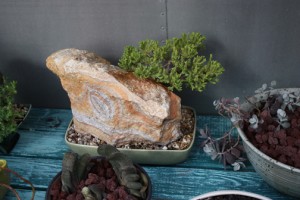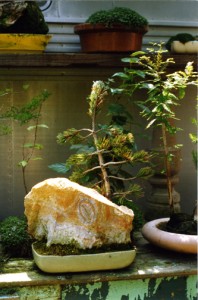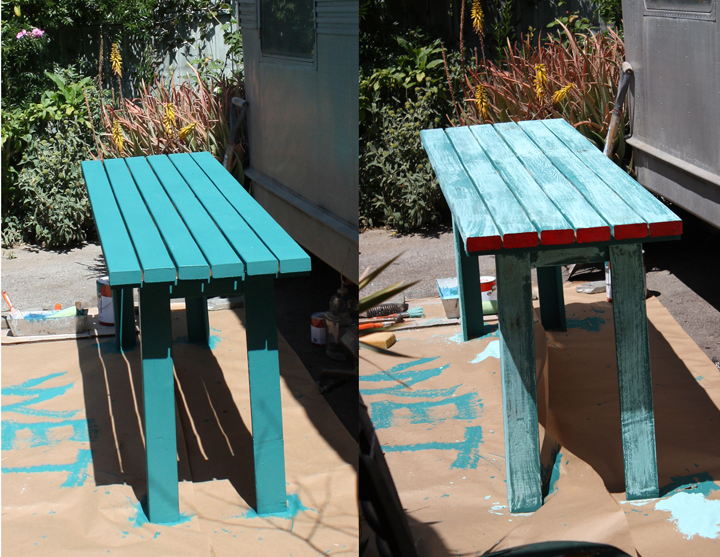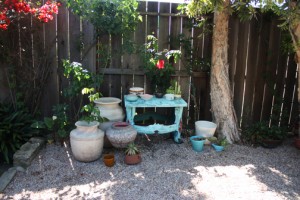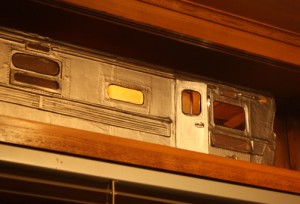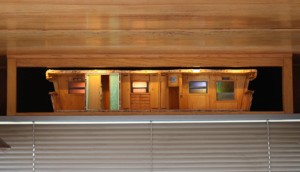Museums and Gardens –
Friday, July 13th, 2012 » By nlowe1 » See more posts from ALL THE NEWS, Peek through the keyhole, RBSC Related
The Spartan Trailer is reunited with part of its garden, and much more.
A detail of the Spartan Royal Mansion Garden arrangement recently reconstructed at the Museum of Jurassic Technology, Culver City CA
In the course of the previous two months the long talked about Spartan Garden reconstruction has been accomplished. Having just returned from the second excursion to the West, this time via a northerly route (Wisconsin, Minnesota North Dakota, Montana, the Idaho pan handle, Washington, Oregon and California). Still very much on the trail of Roger Brown, via Seaside OR, where I visited Dennis Adrian, much as Brown had done in the 1980’s and then traveling onwards south to San Francisco CA to see Phyllis Kind, finally arriving at Culver City on April first. For one month I took residence in the Spartan Royal Mansion at The Museum of Jurassic Technology to complete the models I had begun in the Fall (details on this project is below) and to oversee the re-assembly installation of part of Roger Browns garden alongside the trailer itself. In addition I also supervised the loan of items from the La Conchita Garden collection to Casa Dolores, Linda Cathcart’s recently established Museum of Mexican Folk Craft in Santa Barbara where they will form part of a display in the garden at Casa Dolores a commemoration of Roger Brown’s life in California.
A photograph taken by Roger Brown of one of the plant arrangements alongside the Spartan Royal Mansion Trailer as it appeared in the mid 1990’s
The Spartan Garden, at the Museum of Jurassic Technology, Culver City, CA
The idea for reconstructing sections of the La Conchita Garden grew in part from work completed in preparation for the exhibition, Roger Brown Calif. USA (Hyde Park Art Center, June – Oct, 2010). Since 2008 I have worked with RBSC staff and with students through class projects and with the aid of much additional volunteer help, to assess and re-organize all the objects that were located in the La Conchita garden. And while this process is not yet completed the storage locations of all materials have now been confirmed and all items can be identified via the database by a designated location name that indicates where things once were in the La Conchita garden. In this process it became clear that Roger had organized the garden materials into distinct groups, choosing complementary plants and contrasting shapes with very careful consideration of placing and levels too. These details pointed to certain structural foci and this included the Spartan Royal Mansion trailer.
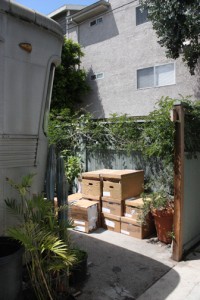 The 35 boxed objects are again reunited with the spartan after 10 years apart, seen here resting on the day of their delivery .
The 35 boxed objects are again reunited with the spartan after 10 years apart, seen here resting on the day of their delivery .
A table was constructed to resemble the one seen in photographs of La Conchita here at The Museum Of Jurassic Technology the new table can be seen getting its final faux-distressed treatment.
 The center image shows Nick holding one of the smallest objects in the collection, a miniature porcelain Greek style vase. The image on the left shows this vase at La Conchita in the late 1990’s and the image on the right as it now appears in the restored arrangement after planting.
The center image shows Nick holding one of the smallest objects in the collection, a miniature porcelain Greek style vase. The image on the left shows this vase at La Conchita in the late 1990’s and the image on the right as it now appears in the restored arrangement after planting.
Through the careful close inspection of photographs taken at La Conchita almost all the former locations and uses of each item from the garden has been established. Being able to understand how Brown had planted each pot, and then how he had arranged and grouped these items has been key in moving the garden reconstruction forward. Following the formal gifting of the Spartan Trailer to the long term care of the Museum of Jurassic Technology in November 2010, (the trailer had been on loan to the Museum by SAIC since 1998) the logic for making an additional gift of related garden items became extremely compelling. Through additional close research an initial set of 55 objects (from a total of over 500) were identified and from these a final list of 34 objects was agreed upon and then shipped to the Museum of Jurassic Technology in Culver City.
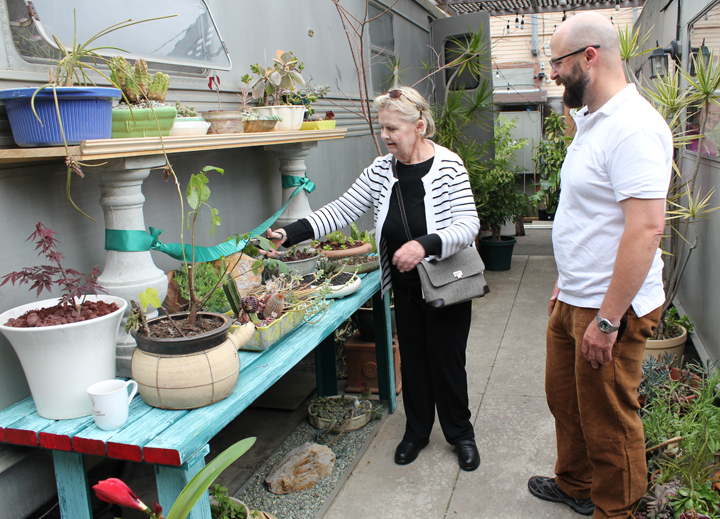 At the opening garden party Linda Cathcart was invited to cut the ribbon.
At the opening garden party Linda Cathcart was invited to cut the ribbon.
http://www.youtube.com/watch?v=7W1so30wkdM&
The Roger Brown Garden at Casa Dolores, Santa Barbara, CA
Casa Dolores, Center for the Study of the Popular Arts of Mexico, was founded by Linda Cathcart as a permanent home for her collection of hand crafted objects from Mexico. Having begun her career at the Whitney Linda went on to make a significant impact at the Albright-Knox Gallery in Buffalo NY where she gave many artists the first museum show of their career, Ed Ruscha, Bruce Nauman and Robert Longo, to name but a few. Meeting Roger Brown in the mid 1980’s when she was Curator at Houston’s Contemporary Arts Museum in Texas. Linda went on to open her own commercial gallery in Santa Monica in the late 1980’s and through it she became known for her support of artists such as Alice Neel, Jim Shaw, and Cindy Sherman. Linda has pursued her passion for Mexican craft objects since she was a child. A passion initially kindled while on family trips to Mexico and that continues to the present day as a collection of over 6000 remarkable items. The establishment of Casa Dolores with its changing and focused exhibitions is beginning to signify the collection as an important source of detail for this kind of material. When becoming better acquainted with Roger Brown in the late 1980’s they both recognized in each other a passion for collecting vernacular objects. Their friendship grew strong via a series of excursions and exchanges that were concerned with seeking out traditional ceramics from Mexico and the mid century North American and Californian ceramics upon which Mexican aesthetics have had such a great influence. The exchange of ideas extended into the arrangements they each made of their collections in their homes and gardens. At Casa Dolores today, Linda readily acknowledges the distinct influence that Roger Brown’s approach to collecting and arranging has bought to her thinking when making her own garden arrangements.
An initial installation of the ceramics on loan to Casa Dolores. The items will be planted and arranged in a manner that evokes the spirit of Roger Brown’s arrangement of these objects as they once appeared in his garden at La Conchita in the mid 1990’s.
In complete recognition of her friendship with Roger and of their creative exchanges over collecting and garden making, Linda has established an area of the garden at Casa Dolores as a garden for Roger Brown. Some years ago she planted two red tea roses intending that they should form an arch as a tribute to Roger who had planted roses of this kind at La Conchita. Linda has talked about how Roger in his use of this particular rose and its combination with cacti, wanted to reflect the decorative horticulture common in the gardens of all the California Missions. Brown visited many of the missions and demonstrated his enthusiasm and love for them by borrowing for his home many of the physical aspects he saw there. The structure and organization of the La Conchita house with its clerestory buildings are alone significant for the way they resemble ecclesiastical buildings but it is in the earth pink color that he painted the exterior of his house in La Conchita that we see the most direct reference to the California missions. Brown insisted the pink should be the exact same tone as that on the walls of the cemetery at La Purisma in Lompoc. The precision and clarity in Brown’s home and garden making at La Conchita is something that had struck Linda as significant to remembering his life in California. In our recent conversations Linda and I had talked about her desire to honor Roger’s La Conchita garden in her own at Casa Dolores by bringing together pots and re-creating plantings for them that echo Roger’s approaches. And it is on this basis that thirteen objects from the La Conchita North garden, the street side of the house, could be offered on loan to Casa Dolores. I was able to personally deliver these objects to Casa Dolores in April and also to spend time with Linda and her staff to advise on their installation and positioning in the garden.
Trailer living – Models and Video’s in the Spartan Royal Mansion
Another main function of my residency at the Museum of Jurassic Technology was to build and install a series of models inside the Spartan Trailer itself. The trailer is replete with niches and closets, and a key aspect of trailer living and trailer design is their economy of space, Spartan trailer design is known in particular for its attention to detail and utility. Discussions with the team at the Museum about installing models in the trailer had begun in the Fall of 2010, and by doing this to bring aspects of Roger Brown’s La Conchita life back to the trailer. Additionally, the Museum of Jurassic Technology has a longstanding interest in mid century trailer design and aside from the Royal Mansion, (Roger Brown’s trailer, formerly moored at La Conchita) David Wilson, the Museum’s creative director also owns a Spartanette, a trailer that predates the Royal Mansion by 10 years or so. Interest in trailer life is also expressed through one of the museum exhibits, “The Garden of Eden on Wheels – Selected Collections from Los Angeles Area Mobile Home and Trailer Parks”. Key to this exhibit are a series dioramas in miniature that show scenes with mobile homes in California settings alongside displays of ceramics and domestic vernacular objects from actual trailer inhabitants in the LA area. The exhibit also features narratives about homeliness and establishes the emotional grounds for a sense of belonging in transience.
The ‘outside’ spartan model installed in the trailer at The Museum Of Jurassic Technology, Culver City CA
The ‘inside’ spartan model installed in the trailer at The Museum Of Jurassic Technology, Culver City CA
My proposal for models inside the trailer was to honor and reference ‘The Garden of Eden on Wheels’, and the ongoing conversation about trailer life at the Museum, while bringing the life of the Roger Brown trailer into focus in parallel to it. While preparing the Hyde Park exhibit I had begun construction of a model representing the South East interior corner of the La Conchita house, complete with replicas in miniature of the collection, furniture and objects and decided that unlike the other previous models which now reside at the Roger Brown Study Collection and function as interpretative material, this new corner model should be installed in the television cabinet that faces the dining and living area of the trailer. This particular closet interested me because it can be accessed from two directions by two doors that are at right angles to each other. In my previous Fall residency I had also begun to devise two more models but this time of the trailer itself. My intention here was to install these trailer models at either end of the trailer, in each of the long niche like shelves that span the narrow space above the end windows. Having begun with a series of scale drawings and models as sketches in the Fall, the two trailer models are now completed and installed also. Each model shows the Spartan trailer as an object in its own right, split in half length-ways, one model depicts the interior East side of the trailer, while the other shows the west outer face. The constructions were made in wood and metal utilizing as closely as possible replica scale materials at one inch to one foot.
http://www.youtube.com/watch?v=1aFPY0hyLnw&list=UULDxyAxwLgx2S1yMowwWJ9g&index=7&feature=plcp
For more details on all of these projects please visit my Sabbatical blog pages –
http://ruftydog.wordpress.com/
Nicholas Lowe, June 2012

